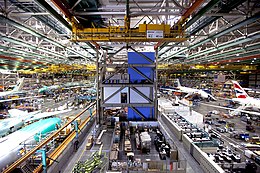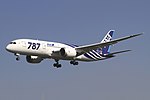
The Boeing 767 is an American wide-body airliner developed and manufactured by Boeing Commercial Airplanes. The aircraft was launched as the 7X7 program on July 14, 1978, the prototype first flew on September 26, 1981, and it was certified on July 30, 1982. The initial 767-200 variant entered service on September 8, 1982, with United Airlines, and the extended-range 767-200ER in 1984. It was stretched into the 767-300 in October 1986, followed by the extended-range 767-300ER in 1988, the most popular variant. The 767-300F, a production freighter version, debuted in October 1995. It was stretched again into the 767-400ER from September 2000.

The Boeing 747 is a long-range wide-body airliner designed and manufactured by Boeing Commercial Airplanes in the United States between 1968 and 2023. After the introduction of the 707 in October 1958, Pan Am wanted a jet 2+1⁄2 times its size, to reduce its seat cost by 30%. In 1965, Joe Sutter left the 737 development program to design the 747. In April 1966, Pan Am ordered 25 Boeing 747-100 aircraft, and in late 1966, Pratt & Whitney agreed to develop the JT9D engine, a high-bypass turbofan. On September 30, 1968, the first 747 was rolled out of the custom-built Everett Plant, the world's largest building by volume. The 747's first flight took place on February 9, 1969, and the 747 was certified in December of that year. It entered service with Pan Am on January 22, 1970. The 747 was the first airplane called a "Jumbo Jet" as the first wide-body airliner.

The Boeing 777, commonly referred to as the Triple Seven, is an American long-range wide-body airliner developed and manufactured by Boeing Commercial Airplanes. The 777 is the world's largest twinjet and the most-built wide-body airliner. The jetliner was designed to bridge the gap between Boeing's other wide body airplanes, the twin-engined 767 and quad-engined 747, and to replace aging DC-10 and L-1011 trijets. Developed in consultation with eight major airlines, the 777 program was launched in October 1990, with an order from United Airlines. The prototype was rolled out in April 1994, and first flew in June. The 777 entered service with the launch operator United Airlines in June 1995. Longer-range variants were launched in 2000, and first delivered in 2004.

The Boeing 737 is an American narrow-body airliner produced by Boeing at its Renton factory in Washington. Developed to supplement the Boeing 727 on short and thin routes, the twinjet retained the 707 fuselage width and six abreast seating but with two underwing turbofans instead of four. Envisioned in 1964, the initial 737-100 made its first flight in April 1967 and entered service in February 1968 with Lufthansa. The lengthened 737-200 entered service in April 1968, and evolved through four generations, offering several variants for 85 to 215 passengers.

A wide-body aircraft, also known as a twin-aisle aircraft and in the largest cases as a jumbo jet, is an airliner with a fuselage wide enough to accommodate two passenger aisles with seven or more seats abreast. The typical fuselage diameter is 5 to 6 m. In the typical wide-body economy cabin, passengers are seated seven to ten abreast, allowing a total capacity of 200 to 850 passengers. Seven-abreast aircraft typically seat 160 to 260 passengers, eight-abreast 250 to 380, nine- and ten-abreast 350 to 480. The largest wide-body aircraft are over 6 m (20 ft) wide, and can accommodate up to eleven passengers abreast in high-density configurations.

A jet airliner or jetliner is an airliner powered by jet engines. Airliners usually have two or four jet engines; three-engined designs were popular in the 1970s but are less common today. Airliners are commonly classified as either the large wide-body aircraft, medium narrow-body aircraft and smaller regional jet.

The Boeing Yellowstone Project was a Boeing Commercial Airplanes project to replace its entire civil aircraft portfolio with advanced technology aircraft. New technologies to be introduced include composite aerostructures, more electrical systems, and more fuel-efficient turbofan engines. The term "Yellowstone" refers to the technologies, while "Y1" through "Y3" refer to the actual aircraft.
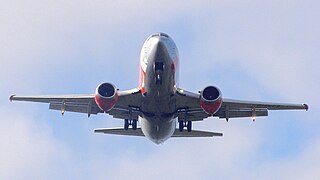
A twinjet or twin-engine jet is a jet aircraft powered by two engines. A twinjet is able to fly well enough to land with a single working engine, making it safer than a single-engine aircraft in the event of failure of an engine. Fuel efficiency of a twinjet is better than that of aircraft with more engines. These considerations have led to the widespread use of aircraft of all types with twin engines, including airliners, fixed-wing military aircraft, and others.

The Boeing Everett Factory, officially the Everett Production Facility, is an airplane assembly facility operated by Boeing in Everett, Washington, United States. It sits on the north side of Paine Field and includes the largest building in the world by volume at over 472 million cubic feet (13,400,000 m3) and covers 98.3 acres (39.8 ha).

As of May 2024, the American Airlines fleet consists of 964 mainline aircraft, making it the second-largest commercial airline fleet in the world. American Airlines operates aircraft manufactured by Boeing and Airbus.

As of May 2024, the United Airlines fleet consists of 952 mainline aircraft, making it the third-largest commercial airline fleet in the world. United Airlines operates a mix of Airbus and Boeing narrowbody and all Boeing widebody aircraft.

The Boeing 777X is the latest series of the long-range, wide-body, twin-engine jetliners in the Boeing 777 family from Boeing Commercial Airplanes. The 777X features new GE9X engines, new composite wings with folding wingtips, greater cabin width and seating capacity, and technologies from the Boeing 787. The 777X was launched in November 2013 with two variants: the 777-8 and the 777-9. The 777-8 provides seating for 384 passengers and has a range of 8,745 nautical miles [nmi] while the 777-9 has seating for 426 passengers and a range of over 7,285 nmi.
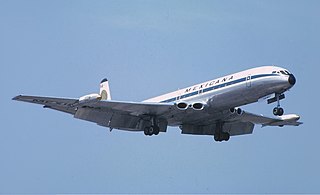
A four-engined jet, sometimes called a quadjet, is a jet aircraft powered by four engines. The presence of four engines offers increased power, allowing such aircraft to be used as airliners, freighters, and military aircraft. Many of the first purpose-built jet airliners had four engines, among which stands the De Havilland Comet, the world's first commercial jetliner. In the decades following their introduction, their use has gradually declined due to a variety of factors, including the approval of twin-engine jets to fly farther from diversion airports as reliability increased, and an increased emphasis on fuel efficiency.
Qantas operates a fleet of Airbus A330, Airbus A380, Boeing 737 and Boeing 787 making a total of 125 aircraft. This list excludes subsidiaries Jetstar, QantasLink and Qantas Freight.
British Airways operates a fleet of Airbus and Boeing aircraft. It operates a single-aisle fleet of Airbus aircraft, including the Airbus A320-200 and the Airbus A320neo. It also operates a twin-aisle aircraft fleet of the Airbus A350-1000, Airbus A380, Boeing 777 and 787.
Japan Airlines operates a fleet of wide-body and narrow-body aircraft from Airbus and Boeing.
Ethiopian Airlines operates a fleet of Airbus A350, Boeing 737, Boeing 767, Boeing 777, Boeing 787 and Bombardier Dash Q-400 aircraft.

This is the history of American aerospace manufacturing company Boeing.
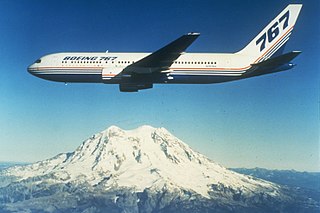
N767BA was a Boeing 767 aircraft that was built by Boeing Commercial Airplanes as the prototype of the 767. The aircraft type was launched as the 7X7 program on 14 July 1978 and rolled of the assembly line on 4 August 1981, later achieving its maiden flight on 26 September. The type was later certified by the Federal Aviation Administration (FAA) on 30 July 1982 with United Airlines being the 767's launch customer. Boeing kept the prototype aircraft for testing throughout its life time. Starting in 1984, Boeing converted the aircraft to an Airborne Surveillance Testbed for a United Sates Army program.

